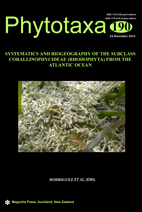Abstract
Two non-geniculate coralline red algae (Lithothamnion corallioides and Phymatolithon calcareum) are partially protected under the assumption that they are the main components of maerl beds in Atlantic Europe. However, what we know about the composition of maerl relies mainly on morphology-based identifications that are notoriously difficult due to a lack of diagnostic features, convergence, and widespread phenotypic plasticity. Now, this state of affairs can be improved with new alternatives that, unlike morphology, allow the unambiguous partition of a large number of rhodoliths into species regardless of their size, shape, and condition (fertile or sterile). Here, we report the first DNA barcoding assessment of the relative abundance of maerl-forming algae. The plastidial gene psbA was sequenced for 1140 rhodoliths from 15 maerl beds scattered along 2000 km from the British Isles to South Portugal; rhodoliths were randomly collected along linear transects to obtain quantitative estimates of species composition. Most (97%) of our collections belonged to three, rather than two, species that often appeared intermixed along a single transect. Lithothamnion corallioides and P. calcareum dominated in the British Isles and Brittany (NW France), but they were gradually replaced by Phymatolithon sp3 in Galicia (NW Spain) and became extremely rare in Algarve (S Portugal). Morphology (rhodolith size and shape, branch diameter, habit) varied considerably between and within beds but the three species converged to a remarkably similar habit when living in sympatry. Still, P. calcareum and L. corallioides seemed to perform best in Brittany while Phymatolithon sp3 produced the largest rhodoliths with thickest branches in Algarve. Altogether, our study shows that the replacement of species of maerl seen in northern latitudes continues to the south along the coasts of Iberia. It also serves as a proof-of-concept of the benefits of DNA barcoding for ecological and biogeographic research of these taxonomically challenging taxa.

